The prime focus of the commercial poultry industry has always been on the making of meat and eggs. Due to the increase in the demands of the chicken and broiler meat all over the world, the modes of production have also been improved. But as they say, increase in the modes of production poses new challenges. The same also holds …
Read More »Health And Welfare
Facts about battery hens or chickens
Farming, the process of adopting various methods for creating food for the survival, has been an important part of human cultivation since the existence of mankind. Farming is a much broader term that is used for various different kinds of farming methods collectively. Farming is not restricted to the growing of crops only, but even the raising of cows, goat …
Read More »
